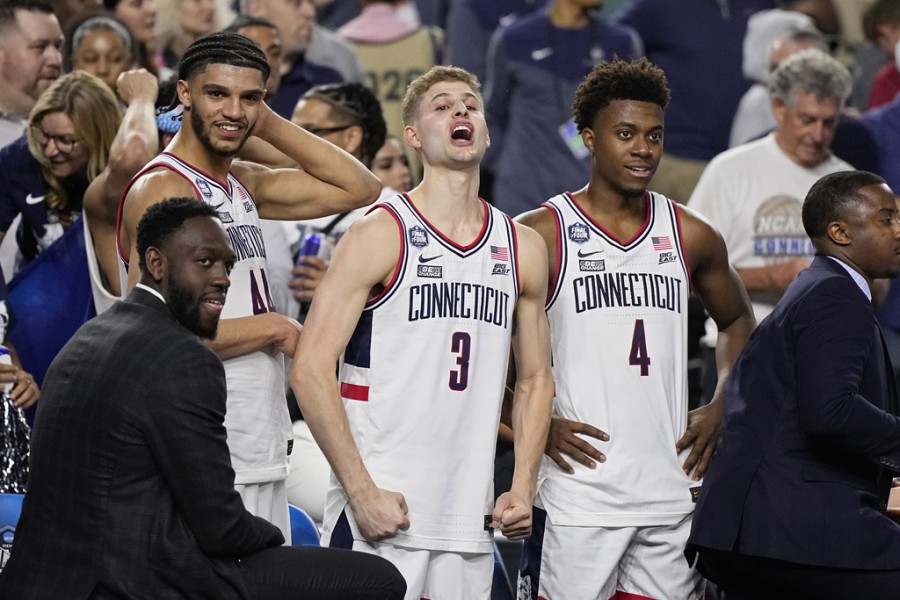HOUSTON — Dan Hurley knew in the wake of a first-round loss in the NCAA Tournament last year that his Connecticut team had to find more perimeter punch to surround his top NBA prospects and match opponents.
Similarly, Brian Dutcher quickly went about luring a new point guard to San Diego State.
So both teams went shopping in the transfer portal, scanning the names of available talent in search of the skillset and fit that would plug gaps in their rosters in the college equivalent to free agency. And while purists grouse about nomadic players destabilizing programs facing constant roster churn, there's no denying its targeted use has worked perfectly for the Huskies and Aztecs: they're the last two teams standing in the NCAA Tournament, playing for the national title Monday night.
“(UConn) needed more offensive weapons and they went to go get them," said Aztecs wing Micah Parrish, who joined San Diego State after two seasons at Oakland. "They needed some more people here for the defensive style and 3-point shooting, and they went to go get us. It just shows that no matter what the team needs, the (portal) can get.
“I feel like there’s good things and bad things about it, but in this situation, I feel like it worked out good.”
The sport is two seasons into the portal era, allowing players the one-time exception to move freely to another school without sitting out the year-in-residence requirement that for so long was part of the deal. It's given coaches the ability to dramatically reshape rosters in short order or hit the market to find the right one or two pieces to elevate a team in a more subtle tweak.
The Huskies (30-8) found help with four perimeter additions in graduate transfer Joey Calcaterra (San Diego), Nahiem Alleyne (Virginia Tech), Tristen Newton (East Carolina) and Hassan Diarra (Texas A&M).
The Aztecs (32-6) added a starting point guard in Darrion Trammell (Seattle) and a rotation guard in Parrish.
“For teams, they kind of are looking for ... not just a point guard, a point guard that can shoot the ball, a point guard that can score, or play-make,” Alleyne said. "Or a shooting guard that can really defend the ball.
“I feel like they don’t just look for a point guard or shooting guard. They look for those intangibles that they have.”
For years, the tournament would reach its Final Four weekend with older teams built through years of players sticking around through most of their eligibility instead of bolting early for the NBA. These days, the older teams that get here are likely featuring players brought in after racking up years of experience and reps on other rosters.
That has made those additions better equipped to jump right in and contribute compared to a freshman adjusting to life away from home for the first time, the college game and trying to find his way across campus.
And it's made it a bit easier to project for coaches what level of production they can expect from a player with a more fully developed game.
At UConn, Hurley looked at how to improve after the Huskies' loss to New Mexico State in the first round of last year's NCAAs. The core was intact with big man Adama Sanogo along with guard Jordan Hawkins and Andre Jackson Jr.; it was just a matter of who played with them.
It was part of the pitch that Hurley's staff gave to Calcaterra.
“When I came on my visit, he definitely mentioned they need some lights-out shooters from the perimeter,” Calcaterra said. “Just guys who were going to expand the paint for Adama to work in there and drag guys out so he has more room to operate. It was definitely a key for them in the offseason and something they were looking for.”
The plan has worked. Newton is a starter averaging 9.8 points as a complementary scorer. Calcaterra is a reserve shooting 44% from 3-point range, while Alleyne and Diarra are rotation players. And UConn went from averaging 113.8 points per 100 possessions last year (ranked 22nd by KenPom) to 120.6 this year (third).
At San Diego State, the Aztecs needed another floor leader after Trey Pulliam had completed his eligibility.
So Dutcher's staff quickly zeroed in on the 5-foot-10 Trammell, who averaged 18.7 points while starting 49 of 54 games over two seasons at Seattle.
That included the staff flying out to see him, delivering a pitch to Trammell while he munched on shrimp scampi at a Cheesecake Factory.
“They made it very clear that it was me that they needed,” Trammell said. “Not this idea of a point guard, but it was Darrion Trammell that they needed. They made that super clear to where it was almost a no-brainer to choose the school.”
Trammell has started all but one game this season, averaging 9.7 points with the capability of playing either guard position. And then there's Parrish, who sacrificed a bigger role (12.1 points in 34.3 minutes per game at Oakland) for the chance to make a deep March run and improve his pro prospects.
He's averaging 7.6 points and shooting 36% from 3 as a key reserve with San Diego State in its first Final Four. And with his team only a win away from cutting down the nets, he figures the bet has paid off — for both sides.
“It just says that as much as coaches need it, the players need it, too — or the other way around," Parrish said. “We need each other."









